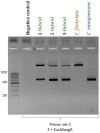Evidence of Biparental Mitochondrial Inheritance from Self-Fertile Crosses between Closely Related Species of Ceratocystis
- PMID: 37367622
- PMCID: PMC10300817
- DOI: 10.3390/jof9060686
Evidence of Biparental Mitochondrial Inheritance from Self-Fertile Crosses between Closely Related Species of Ceratocystis
Abstract
Hybridization is recognized as a notable driver of evolution and adaptation, which closely related species may exploit in the form of incomplete reproductive barriers. Three closely related species of Ceratocystis (i.e., C. fimbriata, C. manginecans and C. eucalypticola) have previously been shown to hybridize. In such studies, naturally occurring self-sterile strains were mated with an unusual laboratory-generated sterile isolate type, which could have impacted conclusions regarding the prevalence of hybridization and inheritance of mitochondria. In the current study, we investigated whether interspecific crosses between fertile isolates of these three species are possible and, if so, how mitochondria are inherited by the progeny. For this purpose, a PCR-RFLP method and a mitochondrial DNA-specific PCR technique were custom-made. These were applied in a novel approach of typing complete ascospore drops collected from the fruiting bodies in each cross to distinguish between self-fertilizations and potential hybridization. These markers showed hybridization between C. fimbriata and C. eucalypticola and between C. fimbriata and C. manginecans, while no hybridization was detected in the crosses involving C. manginecans and C. eucalypticola. In both sets of hybrid progeny, we detected biparental inheritance of mitochondria. This study was the first to successfully produce hybrids from a cross involving self-fertile isolates of Ceratocystis and also provided the first direct evidence of biparental mitochondrial inheritance in the Ceratocystidaceae. This work lays the foundation for further research focused on investigating the role of hybridization in the speciation of Ceratocystis species and if mitochondrial conflict could have influenced the process.
Keywords: Ceratocystis; PCR RFLP; hybridization.
Conflict of interest statement
The authors declare no conflict of interest.
Figures





Similar articles
-
An expanded concept of Ceratocystis manginecans and five new species in the Latin American clade of Ceratocystis.Mycologia. 2024 Jan-Feb;116(1):184-212. doi: 10.1080/00275514.2023.2284070. Epub 2024 Jan 19. Mycologia. 2024. PMID: 38127644
-
Inheritance of phenotypic traits in the progeny of a Ceratocystis interspecific cross.Fungal Biol. 2018 Jul;122(7):717-729. doi: 10.1016/j.funbio.2018.03.001. Epub 2018 Mar 14. Fungal Biol. 2018. PMID: 29880206
-
High-resolution melting curve analysis: A detection assay for Ceratocystis eucalypticola and C. manginecans in infected Eucalyptus.Fungal Biol. 2024 Oct;128(6):2062-2072. doi: 10.1016/j.funbio.2024.07.011. Epub 2024 Aug 6. Fungal Biol. 2024. PMID: 39174241
-
Deletion of the MAT-2 mating-type gene during uni-directional mating-type switching in Ceratocystis.Curr Genet. 2000 Jul;38(1):48-52. doi: 10.1007/s002940000131. Curr Genet. 2000. PMID: 10953881
-
Hybridization in geese: a review.Front Zool. 2016 May 12;13:20. doi: 10.1186/s12983-016-0153-1. eCollection 2016. Front Zool. 2016. PMID: 27182276 Free PMC article. Review.
References
-
- Callaghan S., Guest D. Globalisation, the founder effect, hybrid Phytophthora species and rapid evolution: New headaches for biosecurity. Australas. Plant Pathol. 2015;44:255–262. doi: 10.1007/s13313-015-0348-5. - DOI
LinkOut - more resources
Full Text Sources

